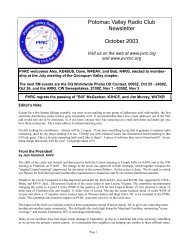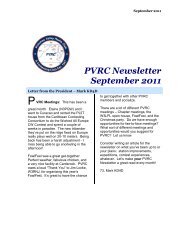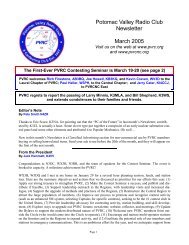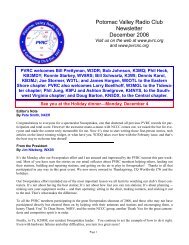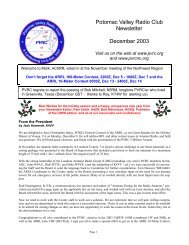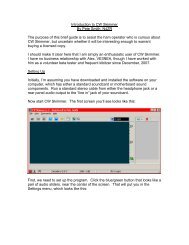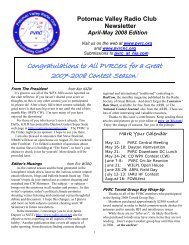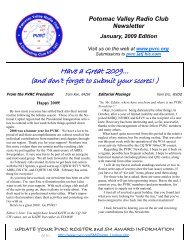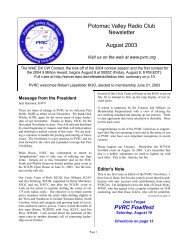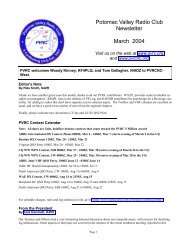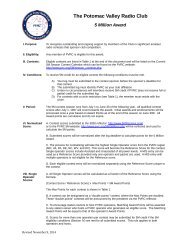NCJ Reviews: The PIEXX TS-930 Microprocessor Board By Pete ...
NCJ Reviews: The PIEXX TS-930 Microprocessor Board By Pete ...
NCJ Reviews: The PIEXX TS-930 Microprocessor Board By Pete ...
- TAGS
- piexx
- microprocessor
- board
- pete
- pvrc.org
Create successful ePaper yourself
Turn your PDF publications into a flip-book with our unique Google optimized e-Paper software.
<strong>NCJ</strong> <strong>Reviews</strong>: <strong>The</strong> <strong>PIEXX</strong> <strong>TS</strong>-<strong>930</strong> <strong>Microprocessor</strong> <strong>Board</strong><br />
<strong>By</strong> <strong>Pete</strong> Smith, N4ZR<br />
Why would anyone, with the millennium almost upon us, go to the trouble of<br />
reviewing an add-on piece of equipment for the Kenwood <strong>TS</strong>-<strong>930</strong>, a radio that<br />
belongs more in the 1980s? Aren’t all the big dogs using FT-1000MPs? Or<br />
Omni 6+s? Or whatever?<br />
Well, no, not really. For many of us, particularly contesters like me who much<br />
prefer CW, it’s still arguable that there is no better radio out there than the <strong>TS</strong>-<br />
<strong>930</strong>. With the surge in SO2R (single operator, 2 radio) operation, budgets are<br />
being stressed to come up with two modern radios. Meanwhile, the used price of<br />
the <strong>TS</strong>-<strong>930</strong> has dropped toward the neighborhood inhabited by much less<br />
capable radios.<br />
<strong>The</strong> big problem with the <strong>930</strong> is that it has always seemed insoluble to add<br />
computer control, because the radio wasn’t designed for it, and lacks any sort of<br />
computer port. For modern SO2R operation, the inability to control the second<br />
radio always seemed to disqualify the <strong>TS</strong>-<strong>930</strong> as a serious candidate.<br />
Now, all this has changed. It began a year or so ago when Chris Sieg, WA3LDI,<br />
was asked to repair a friend’s <strong>TS</strong>-<strong>930</strong>. He discovered that the microprocessor<br />
board had been ruined by leaking memory batteries, and that Kenwood no longer<br />
makes the necessary part. Now, most people would have given up, but Chris<br />
owns and operates an electronic prototyping company, so he has a unique<br />
combination of microprocessor design know-how and PC board production<br />
capability. Even then, most people would have hesitated to take on such a<br />
complex project, but Chris says he decided to do it “for grins.”<br />
<strong>The</strong> result is the <strong>PIEXX</strong> <strong>TS</strong>-<strong>930</strong>SE (enhanced) microprocessor board, which is a<br />
plug-compatible replacement for the original unit in the <strong>TS</strong>-<strong>930</strong>. <strong>The</strong> new board<br />
takes advantage of the advances in microprocessor design that have taken place<br />
since the <strong>TS</strong>-<strong>930</strong> was designed, first and foremost to do away with the<br />
requirement for backup batteries. But that’s only the beginning. Almost as an<br />
afterthought, he says, Chris decided to add a serial port to the microprocessor<br />
board, and implement a subset of the Kenwood communications protocol. That<br />
one decision made him this contester’s best friend, extending the life of my latemodel<br />
<strong>TS</strong>-<strong>930</strong>, which was about to be retired in favor of a <strong>TS</strong>-850, or some other<br />
computer-controllable contest radio.<br />
<strong>The</strong> <strong>TS</strong>-<strong>930</strong>SE’s serial port connects directly to your computer, without the need<br />
for a level converter or added chips inside the radio; already, this threatens to<br />
severely impact the market for <strong>TS</strong>-940s and <strong>TS</strong>-850s, which need one or both.<br />
<strong>The</strong> communications work flawlessly with TR Log and CT 9.39 or later, and Chris
continues to evolve the firmware to make sure it works smoothly with other noncontest<br />
logging software.<br />
Because the <strong>TS</strong>-<strong>930</strong> uses direct mechanical switching for mode control, it cannot<br />
be commanded to switch modes from an external computer. This is a minor<br />
inconvenience in contest applications, compared to gaining the ability to<br />
command band and frequency changes, read frequency into the computer, and<br />
control and clear the RIT from the keyboard or with stored sequences. In all<br />
these respects, the <strong>TS</strong>-<strong>930</strong>SE makes the <strong>TS</strong>-<strong>930</strong> work like a <strong>TS</strong>-850 and other<br />
next-generation rigs.<br />
<strong>The</strong> modern microprocessor used gave him a lot of additional memory space to<br />
work with, so Chris didn’t stop there. <strong>The</strong> <strong>TS</strong>-<strong>930</strong>SE microprocessor does a<br />
number of other tricks. For the contester, these include, in particular:<br />
3-speed main tuning and selectable slow tuning rates – Fast QSY, yet two<br />
slow tuning rates (2.5 and 10 kHz per revolution) for easy fine tuning.<br />
Pre-settable initial frequencies on each band – no more lengthy retuning.<br />
During any operating session, last operating frequency on each band retained<br />
for quick band changes in contest situations.<br />
RIT can be cleared while in Transmit mode. Old <strong>TS</strong>-<strong>930</strong> users will particularly<br />
appreciate this one!<br />
RIT tuning by main tuning knob when D. LOCK pressed. Selectable tuning<br />
rates.<br />
� Pre-settable initial frequencies on each band – no more lengthy retuning.<br />
During any operating sessions, last operating frequency on each band is<br />
saved and returned to if you go back to that band.<br />
� Band data outputs from the microprocessor board are provided, to control the<br />
Top Ten Yaesu/LPT band decoder, enabling fully automatic antenna<br />
selection.<br />
<strong>The</strong> <strong>TS</strong>-<strong>930</strong>SE also gives massively expanded memory capabilities – up to 99<br />
individual memories, while retaining the original switch-selected 8-memory<br />
scheme (one memory is committed, though, to the band-start frequency storage).<br />
An optional minor modification to the radio enables remote S-meter readout<br />
through the serial port, which is used by some software, such as DX4WIN, and<br />
by Kenwood’s own RCP software.<br />
Installation<br />
As mentioned above, the <strong>TS</strong>-<strong>930</strong>SE microprocessor board is plug-compatible<br />
with the original board, requiring no wiring changes unless you choose to<br />
implement the S-meter option, which requires a single connection on the<br />
underside of the radio. My <strong>TS</strong>-<strong>930</strong> had never had the case off in over ten years,<br />
and I do not consider myself technically skilled, but I had no difficulty following<br />
the detailed installation instructions and clear photos provided in the manual, and
the modified board worked immediately. Because some <strong>TS</strong>-<strong>930</strong>s (including<br />
mine) have a wiring modification that reverses the direction of main tuning, I had<br />
to reverse two wires on one of the plugs, but the manual anticipated this and<br />
provided step-by-step instructions. <strong>The</strong> microprocessor board itself is of top<br />
quality surface-mount construction, and should be trouble-free.<br />
<strong>The</strong> serial port on the <strong>TS</strong>-<strong>930</strong>SE is unusual in that it is terminated in a modular<br />
plug, and the connection to the outside world is provided through a modular<br />
telephone cord with a DB-9 connector on the other end. Because of the way the<br />
<strong>TS</strong>-<strong>930</strong> is constructed, there is no easy way to bring this cord out the back of the<br />
radio. However, it would be fairly simple to run it out through the hole left by one<br />
or more of the unused phono plugs on the back of the radio (such as the phone<br />
patch connections), by threading it down and across the underside, inside the<br />
bottom cover. Alternatively, you could do as I did and just bring the modular cord<br />
out through the original sliding cover that gives access to the original battery<br />
compartment. Because the modular cord is flat and thin, this solution is<br />
unobtrusive and will bother only the most fastidious.<br />
If you desire to use the Top ten band decoder output, a second modular cord is<br />
required, of the type used for Ethernet network connections. Again, you’ll have<br />
to decide whether to bring it out from the back or the top.<br />
Operation<br />
I have used my <strong>TS</strong>-<strong>930</strong>SE for about 4 months now, for both routine operation<br />
and contests, including the ARRL Phone and CW DX contests, and the justcompleted<br />
WPX phone. It worked flawlessly with the band-map in TR Log,<br />
providing effortless band changes and S&P QSY to beat the pileup to packet<br />
spots. Running QRO, I saw no difficulty whatever with RF interference, although<br />
I later wound a few turns of the modular cable near the radio through a Radio<br />
Shack snap-on core, just to be safe. Other beta-testers have used the board, in<br />
conjunction with CT, in single and multi-op environments with similar, trouble-free<br />
results.<br />
Conclusion<br />
I am delighted with the new lease on life the <strong>TS</strong>-<strong>930</strong>SE microprocessor board<br />
has given my <strong>TS</strong>-<strong>930</strong>. It would be worth it simply to be able to forget about<br />
changing bands in my contest logger, when I change bands on the radio. <strong>The</strong><br />
new tuning rates have made me a better S&P contester, and the ability to have<br />
TR Log clear the RIT after each CQ is worth its weight in gold. More casual<br />
DXers will find the additional memories a real pleasure, and those who are into<br />
computers will find using the modified radio fascinating.<br />
<strong>The</strong> <strong>PIEXX</strong> <strong>TS</strong>-<strong>930</strong>SE microprocessor board is available for $259 plus $8<br />
shipping (in the continental U.S.) from <strong>PIEXX</strong> Inc., 13 Main Street, Hillsboro New
Hampshire 03244, telephone (603)464-5625. Photographs of the board and the<br />
complete text of the user manual are available on <strong>PIEXX</strong>’s web site,<br />
www.conknet.com/<strong>PIEXX</strong>. An optional programming board, which will permit<br />
changing the microprocessor’s firmware for custom applications, is $40 plus $5<br />
shipping in the continental U.S.



